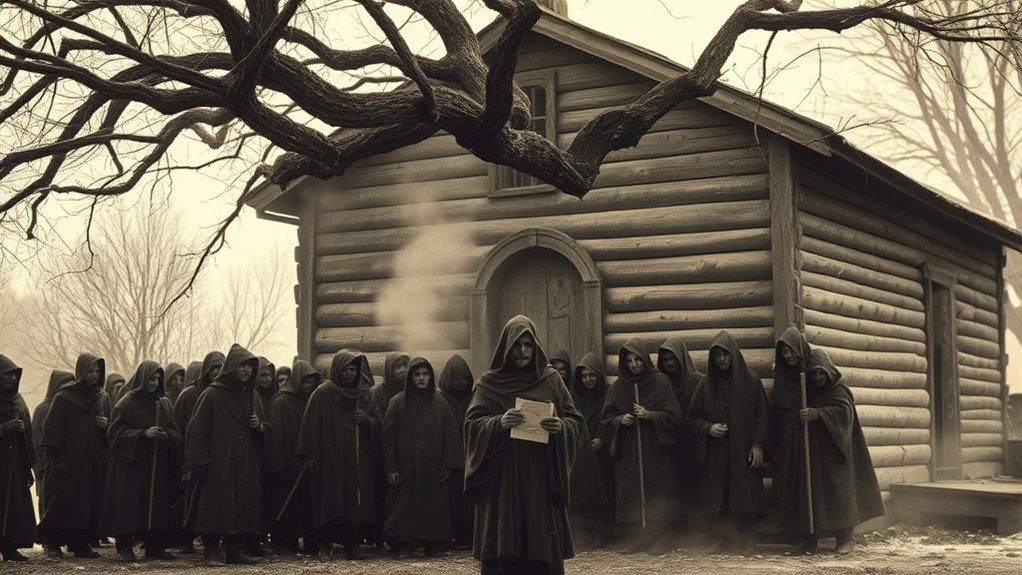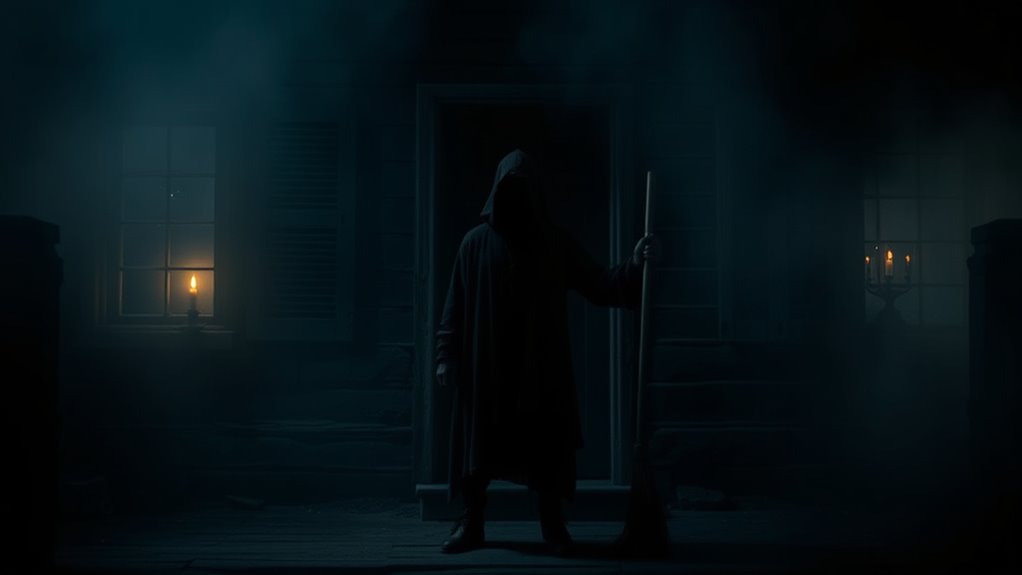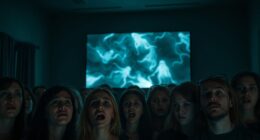In 1692, fear and suspicion took over Salem, causing a wave of hysteria that led to the infamous witch trials. People accused neighbors based on spectral evidence—claims of spirits harming others from afar—which courts accepted as proof of guilt. This superstitious climate made justice unfair, resulting in wrongful arrests and executions. If you keep exploring, you’ll discover how this tragic event highlights the dangers of mass fear and spectral accusations.
Key Takeaways
- The Salem Witch Trials of 1692 were fueled by mass hysteria, fear, and suspicion among the community.
- Spectral evidence allowed accusations based on spectral forms or spirits, despite lacking tangible proof.
- Courts accepted spectral evidence, leading to wrongful convictions and executions of innocent people.
- Fear of supernatural harm and superstitions drove the community’s paranoia and unjust trials.
- The trials serve as a cautionary tale about how mass hysteria and unreliable evidence can distort justice.

Have you ever wondered how fear and suspicion can spiral into mass hysteria? During the Salem Witch Trials of 1692, this is exactly what happened. The town of Salem was gripped by a wave of paranoia, fueled by accusations of witchcraft that seemed to come out of nowhere. One of the most controversial aspects of the trials was the use of spectral evidence—testimony that claimed the spirit or spectral form of a person was seen committing witchcraft. This type of evidence was difficult to prove or disprove, yet it was accepted as valid in court. Spectral accusations played a pivotal role in fueling the hysteria, as many believed that the spirits of accused witches were tormenting others or causing harm through supernatural means. The idea that someone’s spectral form could commit evil acts, even if they were not physically present, led to a dangerous cycle of accusations and convictions.
As the accusations grew, fear spread like wildfire. People started to believe that witches had the power to harm them from afar, often through spectral means. When someone claimed to see the specter of a neighbor tormenting them, it was enough to trigger suspicion. The courts seized on spectral evidence, accepting spectral accusations as proof of guilt. This was a turning point because it meant that the physical presence of the accused was no longer necessary for conviction. Instead, spectral appearances and accusations became the basis for sentencing. This shift created a climate where innocent people could be accused simply because others saw their spectral form in a nightmare or vision. The reliance on spectral evidence made the trials especially unfair, and many innocent individuals suffered because of spectral accusations. This reliance on spectral evidence reflected the superstitions and beliefs about the supernatural that dominated the era.
You might find it shocking how spectral evidence, which today seems highly unreliable, was once considered credible enough to condemn lives. The judges and community believed that spectral forms were real representations of the accused’s true nature, even without tangible proof. This belief was reinforced by the widespread fear and hysteria that gripped Salem, which made rational judgment difficult. These fears contributed to a climate where accusations could be made with little to no evidence, fueling the chaos. This belief made it easier for fear to override rational judgment, leading to a surge in accusations and convictions. The hysteria reached a fever pitch as accusations snowballed, with spectral evidence playing a central role in accusations of witchcraft. The tragic consequence was that many innocent people were accused, tried, and executed based on spectral claims that could not be proven or discredited. The Salem Witch Trials serve as a stark reminder of how fear, when combined with spectral evidence and spectral accusations, can distort justice and turn communities against their own members.
Frequently Asked Questions
Were Any Men Falsely Accused During the Trials?
You might wonder if any men were falsely accused during the Salem Witch Trials. Yes, male involvement did occur, and some men faced false accusations fueled by mass hysteria. These accusations often stemmed from fear and suspicion, leading to unjust punishments. It’s important to recognize that, despite the focus on women, men also suffered from false accusations, highlighting how fear can distort justice during such turbulent times.
How Did the Trials Influence American Legal Practices?
Imagine the scales of justice finally finding their balance. The trials led to pivotal legal reforms, raising evidentiary standards and refining jury procedures. You learn that these changes aimed to prevent panic from clouding judgment and guarantee fair trials. As a result, American legal practices grew more structured and cautious, emphasizing proof over suspicion, and safeguarding innocent lives from the chaos of fear-driven accusations.
What Role Did Local Politics Play in the Hysteria?
You can see that local politics fueled the hysteria by amplifying community divisions and enabling political influence. As tensions rose, leaders exploited fears to strengthen their power, often targeting specific groups or individuals. These divisions made it easier to spread accusations, creating a cycle of suspicion and paranoia. The political climate turned personal conflicts into accusations of witchcraft, demonstrating how local politics directly contributed to the widespread fear and chaos.
Were Any of the Accused Witches Ever Proven Innocent?
Ever wonder if any accused witches were truly innocent? During the Salem witchcraft accusations, none were officially proven innocent through exoneration. The trials mainly focused on confessions and spectral evidence, making innocence difficult to establish. So, while some might have been falsely accused, the hysteria prevented any formal innocence exoneration. The fear and chaos overshadowed justice, leaving many innocent people convicted or executed without clear proof of guilt.
How Did the Salem Community Recover Afterward?
After the trials, your community focused on healing by acknowledging the injustices and working to rebuild trust. They held public apologies and official exonerations, which helped with community healing. To preserve the legacy, they established memorials and educational programs, ensuring future generations remember the tragic events. This process allowed Salem to recover emotionally and culturally, turning a dark chapter into a lesson about justice and the importance of safeguarding human rights.
Conclusion
As you reflect on Salem’s haunted past, remember how fear became the shadow that consumed reason. The trials symbolize a mirror, revealing how hysteria can distort truth and turn community into chaos. Just as the witch’s mark once hid guilt, so too does fear conceal our own vulnerabilities. Let this dark chapter remind you to seek understanding over suspicion, and to recognize the peril in allowing fear to be the guiding force—lest history repeat itself in shadows.









